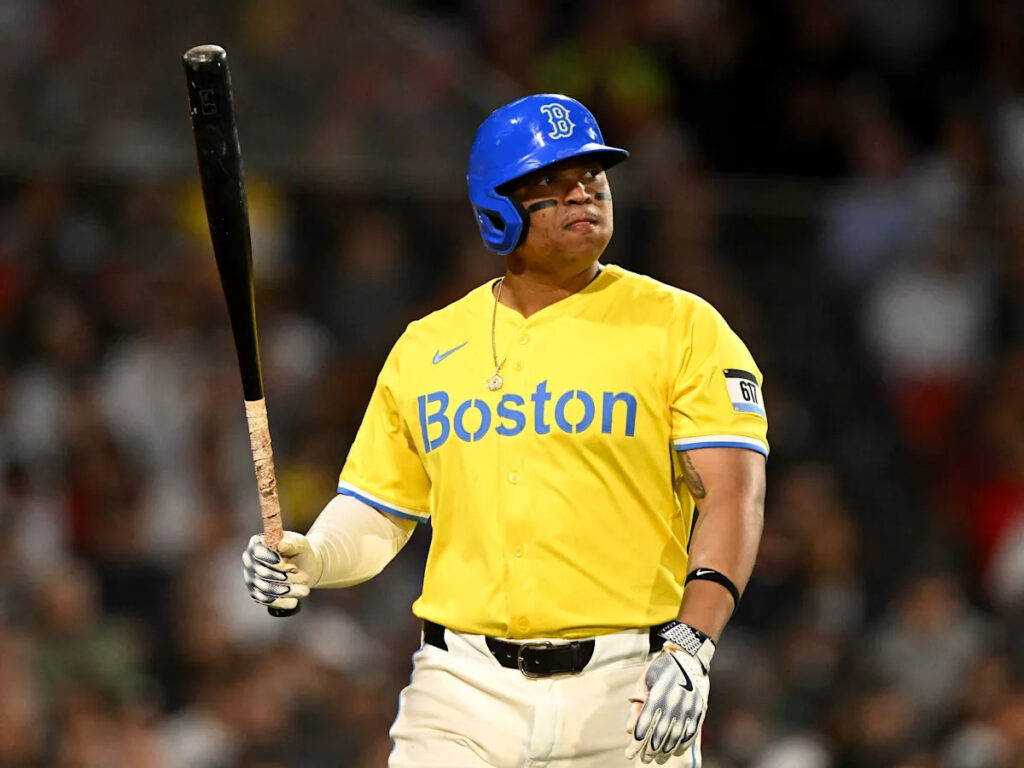Since Barry Bonds retired in 2007, the San Francisco Giants have not had a player launch 30 homers in a season. That not-so-fun fact — which has stretched through a golden era of San Francisco baseball — is, all of a sudden, in jeopardy.
That’s because Rafael Devers, he of 215 career long balls, is now a San Francisco Giant.
In a blockbuster deal that rattled the baseball world on Sunday, the former Red Sox slugger was dealt to San Francisco for Kyle Harrison, Jordan Hicks, James Tibbs III and Jose Bello. Devers’ arrival should provide an immediate boost to a Giants team that finds itself in the thick of the playoff chase: 10 games over .500, two games behind the Dodgers in the NL West and 2.5 games clear in the wild-card race.
It has been an encouraging first season under new president of baseball operations Buster Posey, a franchise icon who took control of the club in September. This headline-grabbing deal is a sign of intent from the inexperienced exec, a high-risk, high-reward move that instantly makes the Giants one of MLB’s most compelling clubs.
Offensively, the fit is obvious. Devers is a reliably sensational hitter at his absolute peak, a difference-making bat enjoying a career year. His .905 OPS through play on Sunday is the 13th-highest mark in baseball. He is one of only seven players with an on-base percentage above .400. Since 2019, he has the sport’s 11th-best OPS. Quite simply, Devers has never not hit. Even in the spacious, pitcher-friendly confines of Oracle Park, he will, almost certainly, continue to hit.
And while the Giants are off to an encouraging start in 2025, their lineup has been uninspiring, mediocre, dull. San Francisco is middle-of-the-pack or worse in most offensive categories. They have the 14th-most runs scored in baseball. Their park-adjusted OPS is 1% below league average. They’ve hit just 69 home runs, which ties them for 20th. Their hard-hit rate (batted balls over 95 mph) is third-to-worst in MLB.
Quite simply: This was not an offense capable of winning a championship.
Devers, and his electrifying presence, can reorient that reality. For 2025 and beyond.
Where does Devers fit on defense?
From a defensive perspective, however, the Devers dynamic in San Francisco is not much clearer than it was in Boston.
The Red Sox decided to trade their franchise cornerstone, in part, because Devers was generally resistant to adopt new positions. A middling defensive third baseman for most of his career, Devers reluctantly moved to DH this spring after Boston signed perennial All-Star Alex Bregman. But when Red Sox first baseman Tristan Casas went down with a season-ending leg injury, the chaw-chomping Dominican pridefully refused to slide in at first.
And now he joins a team with relatively similar roster constraints. Matt Chapman is one of the best third-base defenders in the game. He signed a six-year, $151 million extension in September and is regarded as a key clubhouse presence. There’s no reason to expect he won’t man the hot corner at Oracle for the foreseeable future.
The Giants’ first-base spot, meanwhile, is alluringly open. LaMonte Wade, a club staple for a half-decade, was jettisoned on June 4 after an abysmal start to 2025. His temporary replacement, journeyman lefty Dominic Smith, has performed well but isn’t a long-term answer. Veteran righty Wilmer Flores has settled in as San Francisco’s every-day DH. Whether Devers would be open to playing first base in San Francisco, something he was decidedly unwilling to do in Boston, is yet to be determined. Whatever he decides, Flores and Smith would likely platoon at either DH or first base while Devers would slot in at the other spot.
But if Devers doesn’t change his tune and continues to pass on playing first, it would clog up San Francisco’s DH spot. That’s potentially notable in the long term, as the Giants’ top prospect, Bryce Eldridge, is a 20-year-old first baseman with light-tower power currently in Triple-A. Prospects are volatile, and there are worse problems than penciling in Eldridge and Devers at DH and first for the next half-decade, but it would create the exact type of roster logjam that compelled Boston to trade Devers.
What about the money?
Also, the addition of Devers represents yet another significant financial commitment for the Giants in the Posey era. Multiple outlets reported that Boston will not cover any portion of the more than $250 million remaining on the 10-year, $313.5 million extension Devers signed in January 2023. As such, his $29.5 million annual salary immediately becomes the club’s biggest financial outlay. This past winter, Posey oversaw the largest contract in franchise history, a seven-year, $182 million deal for shortstop Willy Adames. And while former president of baseball operations Farhan Zaidi was technically still in charge during the Chapman negotiations, multiple reports indicated that Posey, then a member of the board and a minority owner, played a significant role in that contract as well.
Nearly every team in baseball has the rest of the Devers’ contract evaluated as a large overpay. The Giants, in taking on this deal, will pay the not-so-lithe slugger through the 2033 season. As Devers rounds his 30th birthday, there’s a chance that the physical decline comes fast and swift. Posey’s decision to take on such a notable yet potentially rewarding risk is the first major sign that the former MVP won’t be beholden to the statistical models that shape the decision-making of most other baseball executives.
For Posey, it appears, the math is more straightforward. His lineup needs help. Devers, even at a high price, should provide ample reinforcements. None of the pieces going to Boston was integral to the 2025 Giants, a team that now has a legitimate path to October baseball.
Altogether, in Posey’s mind, Devers was worth paying for. Time will tell if he’s correct.
Read the full article here

